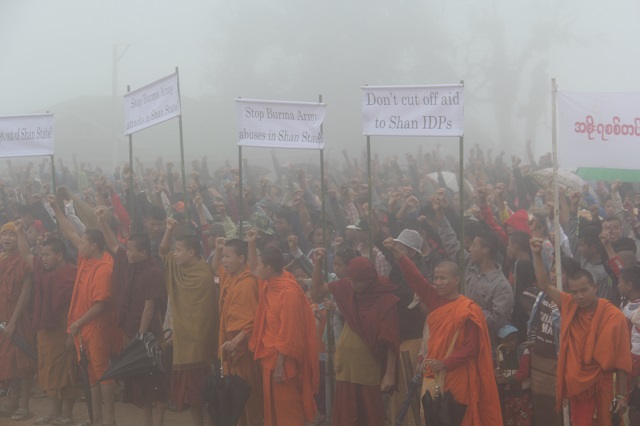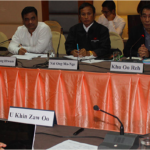By Sai Wansai / Shan Herald Agency for News (SHAN) | September 5, 2017
While the conflict situation in Arakan State is making international headlines, a little less known catastrophe in the making is brewing along the Thai-Burma border among the Shan refugees.
Following notification of aid termination to the Shan refugees and Internally Displaced Persons (IDPs) along the Thai-Burma border from The Border Consortium (TBC), an umbrella group that coordinates international aid deliveries, angst for future and unsettling situation are rife as the aid termination for the end this month draws nearer each day.
The appeal
As it is, more than 6,000 Shan refugees, currently living in six camps along the Thai-Burmese border, are about to suddenly face with the prospect of surviving without support from the international community, according to Shan Human Rights Foundation (SHRF) report.
 The six camps affected are: Kong Moong Murng Camp, opposite Mok Cham Pae, Mae Hong Son province; Loi Tai Laeng IDP camp, opposite Bang Ma Pha, Mae Hong Son province; Loi Lam IDP camp, opposite Wiang Haeng, Chiang Mai province; Koung Jor refugee camp, Wiang Haeng, Chiang Mai province; Loi Sam Sip IDP camp, opposite Fang, Chiang Mai province; and Loi Kaw Wan IDP camp, opposite Mae Fah Luang, Chiang Rai province.
The six camps affected are: Kong Moong Murng Camp, opposite Mok Cham Pae, Mae Hong Son province; Loi Tai Laeng IDP camp, opposite Bang Ma Pha, Mae Hong Son province; Loi Lam IDP camp, opposite Wiang Haeng, Chiang Mai province; Koung Jor refugee camp, Wiang Haeng, Chiang Mai province; Loi Sam Sip IDP camp, opposite Fang, Chiang Mai province; and Loi Kaw Wan IDP camp, opposite Mae Fah Luang, Chiang Rai province.
Four of those makeshift villages are recognized as IDP camps, meaning they shelter internally displaced persons, or IDPs, because the camps reside on the Burmese side of the border, according to the recent report in Shan Herald Agency for News (SHAN).
On August 30, 2017, Shan State Refugee Committee (Thai Border) and SHRF issued a statement outlining the impossible dire situation that the Shan refugees would face if they return and pleaded for the continuing aid delivery. Part of the statement wrote:
- We appeal to international donors not to cut off this aid while the peace process is still so uncertain.
- We cannot yet return to our homes, because our villages are now derelict, or have been occupied by the Burma Army, their militia or the United Wa State Army (UWSA).
- Despite the peace process, the Burma Army has expanded its troops, and is continuing to carry out military operations and attacks around our villages. Villagers continue to be arrested, tortured and killed.
- We appeal for our rights as refugees to be respected – the right to receive adequate humanitarian aid, and to be given protection until we can return in safety and dignity to our homes once there is a political settlement and genuine peace in Shan State.
Shan displacement
SHRF report said that refugees have been fleeing from Shan State to Thailand for decades to escape the civil war and Burma Army persecution, but did not flee in large numbers until the 1990s.
The dramatically increased number of refugees from Shan State was due to two key factors, one is the massive scorched earth campaign by the Burma Army in central Shan State beginning in 1996, and the other, the forced resettlement of Wa villagers from northern to southern Shan State beginning in 1999.
Forced relocation
The Burma Army’s 1996-1998 scorched earth campaign in central Shan State was the first reason of the Shan displacement.
After the surrender of the Mong Tai Army (MTA) at the end of 1995, MTA remnants, led by Lt. Gen Yawd Serk, formed a new Shan resistance group, the Shan State Army – South (later called the Restoration Council of Shan State/Shan State Army – RCSS/SSA). In March 1996, in an attempt to cut off support for this new group, the Burma Army began a massive scorched-earth operation in central Shan State, driving the rural population at gunpoint off their lands into guarded resettlement camps near towns and main roads.
The results of this operation were devastating. During 1996-1998, over 300,000 people from 1,400 villages were forced from their homes. Those resisting or caught sneaking back to their fields were shot on sight or tortured by Burma Army troops. SHRF documented the killing of over 600 civilians during this time, including the well-known massacre of 56 villagers, including women, in Kunhing, on June 16, 1997. These villagers had been given permission to travel by ox-cart to collect rice from their old villages, but were arrested and shot dead by Burma Army troops on the way.
There was also widespread use of rape as a weapon of war. The 2002 report by SHRF and Shan Women Action Network (SWAN), Licence to Rape, documented rape and other forms of sexual violence against 625 women and girls by troops from 52 different Burma Army battalions, mostly in the areas of forced relocation in Shan State. 61% of the women were gang-raped. 25% were killed, some horribly mutilated.
Terrorized by these atrocities, and unable to survive in the relocation sites, many of the relocated villagers fled to Thailand. Entire families, including elderly grandparents and young children, fled together, using any means – trekking through the jungle, rafting along the Salween River and renting cars — to reach the border.
By May 1996, tens of thousands of villagers had fled into northern Thailand, mainly dispersing into farms and orchards to find work as labourers or wait for the chance to move to construction sites in towns such as Chiang Mai. As illegal migrants, the refugees were vulnerable at all times to arrest and deportation, as well as exploitation by unscrupulous brokers and employers. Too afraid to venture from their work-sites, some refugees died of treatable illnesses. Children had no access to schooling and faced health and safety threats from living in crowded, unsanitary work sites, often exposed to harmful chemical pesticides.
Wa resettlement
The second reason for the massive Shan’s displacement was because of the forced Wa resettlement to southern Shan State in (1999-2001).
In late 1999, the Burmese military regime authorized the UWSA, which had signed a ceasefire agreement since 1989, to begin mass forced resettlement of Wa villagers from the Chinese border down to southern Shan State.
The pretext for the resettlement was drug eradication: to move Wa villagers from the mountainous poppy-growing regions in the north down to more fertile farmlands along the Thai border, where they could grow alternative crops. The real reason was political: using ongoing divide and rule tactics, the regime wanted to pit the UWSA against the RCSS/SSA, and weaken Shan resistance in southern Shan State.
Between 1999 and 2001, over 126,000 villagers – about a quarter of the total Wa population in Burma — were forcibly relocated from the six northern Wa townships down to the townships of Tachileik, Mong Hsat and Mong Ton along the Thai border. The move inflicted huge suffering on the Wa villagers, who were forced to abandon their homes and possessions in the north. Diseases were rife in the resettlement sites and thousands died, according to the Lahu National Development Organization (LNDO) report of 2002.
The large influx of new settlers caused severe disruption for existing villages – mainly Shan, Lahu and Akha – in southern Shan State. Houses, land, crops and livestock were seized without compensation, and in some areas UWSA started taxing and conscripting local villagers. Thousands of local villagers could not bear this oppression and fled to other areas of Shan State or to Thailand.
Over 16,000 Wa were resettled in the Mong Karn area along the Nam Sai river in eastern Mong Hsat, where there were originally six villages, with about 1,200 inhabitants, who were mostly Shan. When heavy fighting broke out between the RCSS/SSA and Burma Army near this area in early 2001, the Burma Army and UWSA began persecuting Shan villagers suspected of supporting the Shan troops. Hundreds of Shan villagers from Mong Karn fled to the Thai border, where they set up the Loi Kaw Wan IDP camp. The original homes and lands of the Mong Karn inhabitants have now all been seized by the UWSA.
Current situation in Shan State
According to “ Deciphering Myanmar’s Peace Process 2016”, published by Burma News International (BNI), RCSS clashed 13 times and Shan State Progress Party/Shan State Army (SSPP/SSA) 34 times with the Burma Army in 2015. In 2016, RCSS clashed 6 times and SSPP 9 times with the Burma Army. However, this is just a conservative estimate and both the RCSS and SSPP said the real encounter is much more than has been reported.
Despite the peace process, it is still impossible for the displaced villagers in camps along the Thai-Shan border to return home. The Burma Army has not adhered to its ceasefire agreements with the RCSS/SSA, and has continued its military expansion and operations throughout southern Shan State. Civilians continue to face systematic abuse.
Any premature forced relocation of the refugees back to Shan State would be unthinkable, as human rights violations are still ongoing.
Widespread arrests, torture, disappearance of civilians under high-level Burma Army operation in Ho Pong after fighting with Nationwide Ceasefire Agreement (NCA) signatory RCSS/SSA are stark reminder of the futile situation not conducive for the return of the refugees.
During July 16-30, 2017, hundreds of Burma Army troops from at least eight battalions patrolled through three village tracts in Ho Pong township, southern Shan State, arresting and torturing civilians, in what appears to be collective punishment for an armed clash with the RCSS/SSA in the area on July 14, 2017.
Hundreds of the original villages of the refugees have either now fallen derelict, or are occupied by the Burma Army, government militia or UWSA.
For example, the township of Mong Nai – one of eleven townships where forced relocation took place — used to have a total of 224 villages before 1996. Today, according to official township immigration lists, only 83 villages remain (of which 27 are “new” villages). 141 villages have been completely erased.
Apart from that, for IDPs who fled from areas of Wa resettlement in eastern Mong Hsat, their original homes are now occupied by Wa settlers. The former Shan villages in the Mong Karn valley have now all been completely taken over by the UWSA.
The threat of permanent loss of lands by planned mega-projects implementation is also very real and worrying.
Refugees from areas where the Burmese government has planned large hydro-power dams or mining projects will lose their homes forever if these projects go ahead.
For example, the giant Mong Ton dam on the Salween River, a joint venture with Thai and Chinese companies for export of power to Thailand, will submerge vast tracts of land along the Pang tributary in Kunhing township. Nearly 50,000 people were forcibly relocated from this area in 1996-1998. If the dam goes ahead, many will never be able to return home.
Similarly the large lignite mine and coal fired power plant project planned by the Burmese military-owned Myanmar Economic Corporation and Italian-Thai Power Company in Mong Kok, Mong Hsat township, will make the entire tract, with over 1,000 Shan, Lahu and Akha residents, uninhabitable. IDPs in Loi Kaw Wan camp who fled Burma Army persecution in Mong Kok, will be unable to return home if this project goes ahead. The project has been stalled for about six years as a result of protests from the Thai side of the border (due to potential pollution of the Kok River, one of northern Thailand’s main waterways.) However, since August 2017, the project has resumed, and villagers have been ordered out of the mining area.
Adding to all these bleak situation and hopelessness to return home anytime soon, the condition for self-sustenance is not at all possible for the refugees due to lack of arable land near the camp sites. Besides, 70% of the camps’ population are children, old people and women.
Perspective
On top of all these negative aspects, the political and military atmosphere are also not at all favourable for the Shan refugees to return.
The ongoing on and off armed confrontation between the Burma Army and the Northern Alliance – Burma (NA-B), in which the Kokang or Myanmar National Democratic Alliance Army (MNDAA), Ta’ang National Liberation Army (TNLA), Kachin Independence Army (KIA) and Arakan Army (AA) are involved is directly and indirectly influencing the political situation of achieving peace and reconciliation within Shan State and beyond.
The members of NA-B are also part of the seven-party political alliance Federal Political Negotiation and Consultative Committee (FPNCC) led by the UWSA. But although it is said to be formed to conduct political negotiation with the government, it is not clear if this political alliance would become a military one also, if one of its member is militarily attacked by the Burma Army.
Meanwhile, the AA ambushed the Burma Army in Arakan State on August 31 as the latter was said to intrude into its area of operation. In the incidence six of the Burma Army’s soldiers were killed, with a sizeable loss of war weaponry. The following day Burma Army made an announcement vowing to crush the AA.
Of course nobody knows if the FPNCC would come to AA’s rescue if massively attacked by the Burma Army in Arakan State by opening new war fronts in Shan State as an alliance, to take away the heat. However, one thing that shouldn’t be forgotten is that the Burma Army and the FPNCC are on war-footing which haven’t even started the peace negotiation process, despite China’s pressure on both conflict parties.
The clashes between the Burma Army and the two Shan armies, the RCSS signatory of the NCA and the SSPP member of the FPNCC, have been going on and off for the last couple of years without any sign that effective ceasefire could be achieved. Besides, on political front, the Burma Army has been blocking the Shan National Conference to take place, which according to the NCA is allowed and a necessary step to sound out the Shan population’s political aspirations to be presented in the 21st Century Panglong Conference (21CPC).
To sum up the whole situation with the given facts available, it is fair to say that forcing the Shan refugees indirectly to return by cutting the aid would be a disaster and also counter-productive. And the international community should continue to uphold and respect the rights of refugees, by continuing the support with adequate humanitarian aid and protection until they could return home safely once political settlement and genuine peace prevail in the Shan State.
This article originally appeared on SHAN on September 5, 2017.







